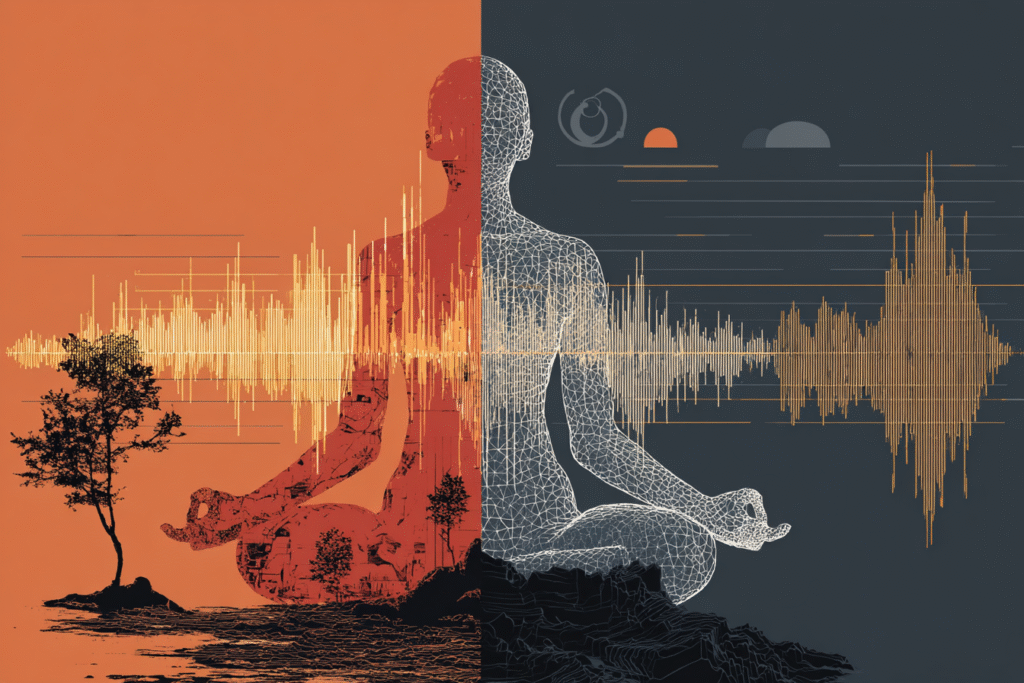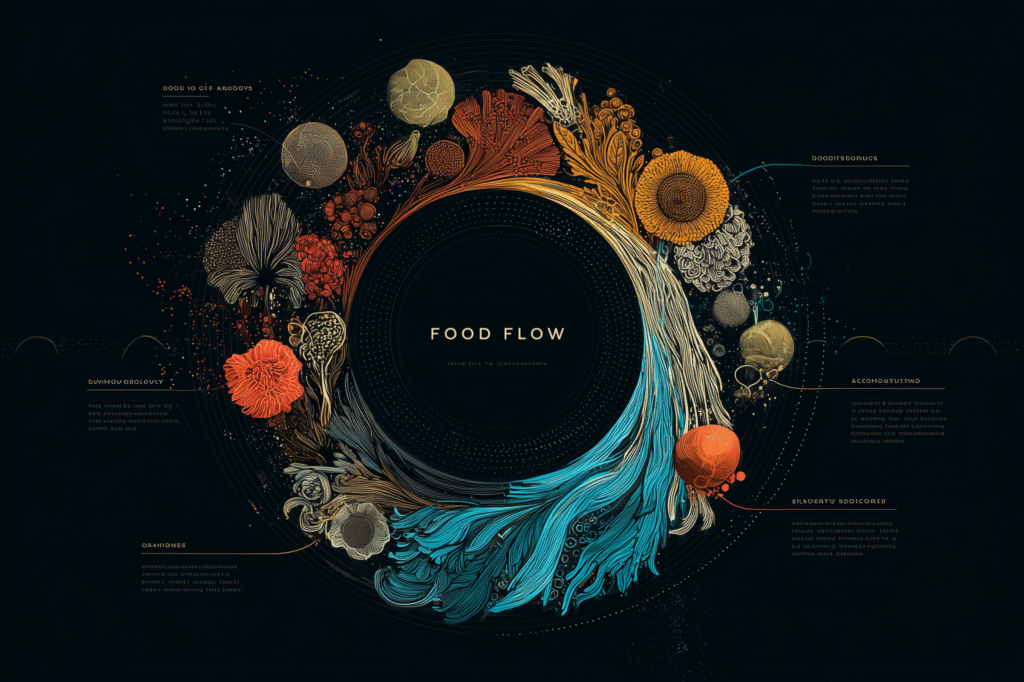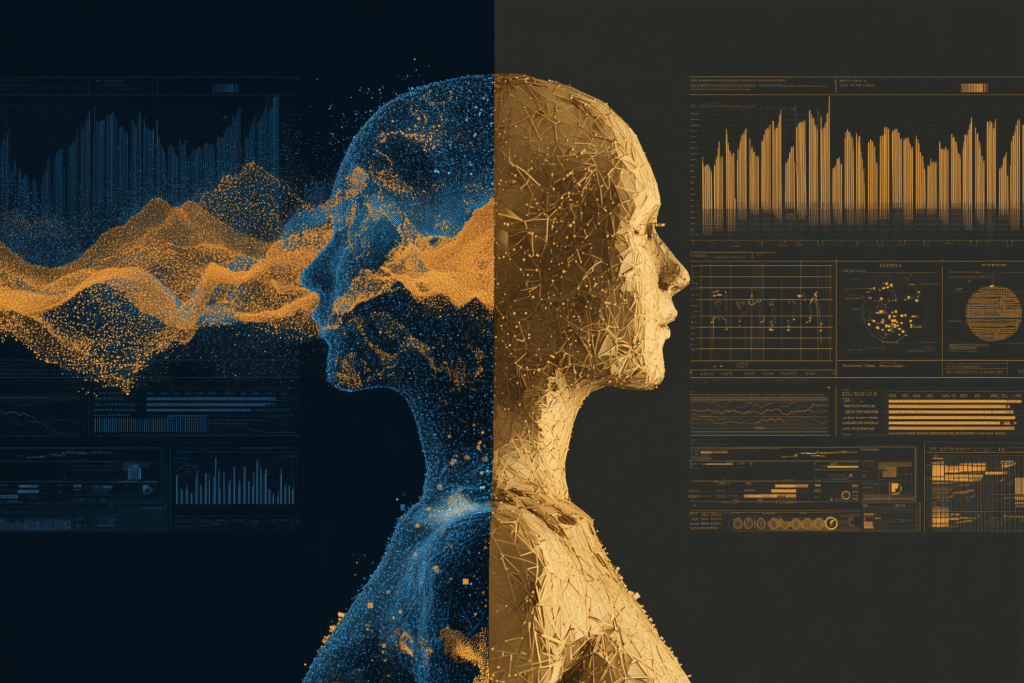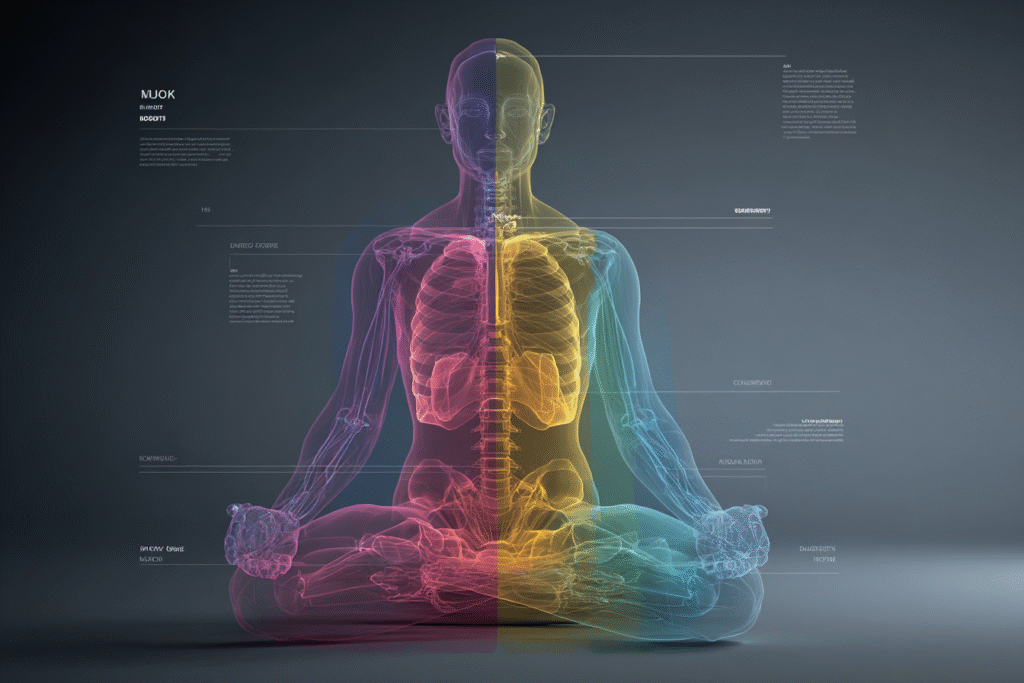Your body sends 11 million signals per second to your brain, yet most people can’t tell hunger from habit.
Note: This article is for educational and informational purposes only. See full disclaimer at the end.
Picture yourself in that afternoon meeting when mental fog creeps in three hours after lunch. For years, you might have pushed through with coffee or ignored it entirely. But what if you paused and asked a different question:
What if this isn’t weakness, but information?
This isn’t the dramatic blood sugar crash that demands immediate attention with shakiness and irritability. This is different—gentler, more sophisticated. Your body speaking in whispers rather than shouts, offering information rather than making demands.
Learning your body’s food signals transforms eating from guesswork into informed guidance—precision grounded in experience, not rigidity.
The Information Revolution We Missed
Yesterday, we explored how food functions as information—biological software that communicates with every system in your body [7]. But there’s a complementary truth we’ve largely forgotten: your body is constantly sending information back, creating a sophisticated feedback loop that, when properly interpreted, becomes your most powerful tool for optimal nutrition.

This biological feedback system evolved over millions of years to keep us healthy, energized, and thriving. Yet most of us have become functionally illiterate in our own body’s language, relying instead on external rules, rigid meal times, and calorie counting to guide our eating.
The consequences of this disconnection are profound. We eat when we’re not hungry, ignore genuine satiety signals, and miss the subtle communications that could guide us toward our most nourishing choices [10]. We’ve traded biological wisdom for algorithmic eating, and our health has suffered for it.
Beyond the Hunger-Fullness Binary
Traditional approaches to biological feedback focus almost exclusively on hunger and satiety—am I hungry or full? But your body’s food signaling system is far more nuanced and informative than this simple binary [11].
Research in interoceptive awareness—your ability to sense internal bodily signals—reveals that our bodies provide continuous feedback across multiple domains [12]:
- Energy Signals: The quality and sustainability of your energy throughout the day
- Cognitive Signals: Mental clarity, focus, and cognitive processing speed
- Mood Signals: Emotional stability, stress resilience, and overall wellbeing
- Digestive Signals: Comfort, satisfaction, and digestive efficiency
- Recovery Signals: Sleep quality, morning energy, and physical recovery
Each meal, snack, and food choice generates feedback across all these dimensions. Learning to read these signals transforms eating from guesswork into precision.
The Science of Biological Feedback
Your body’s feedback system operates through multiple interconnected pathways that create a comprehensive information network [1].

Hormonal Communication: Ghrelin signals energy needs, leptin indicates sufficiency, while insulin and glucagon regulate energy availability. These hormones don’t just control hunger—they influence mood, cognition, and energy levels [2].
Neurological Responses: The vagus nerve provides real-time communication between your gut and brain, transmitting information about food quality, digestive comfort, and nutritional adequacy [8].
Metabolic Feedback: Blood glucose stability, ketone production, and cellular energy availability create patterns of sustained energy versus crashes and cravings [13].
Microbiome Signaling: Your gut bacteria influence mood, cognitive function, and food preferences through neurotransmitter production and inflammatory signaling [3].
The Human-AI Partnership in Signal Reading
This is where the Human-AI Health Partnership framework from Day 56 becomes particularly powerful. While AI excels at pattern recognition across large datasets, it cannot feel your internal signals. But it can help you identify patterns you might miss.
- What You Bring: Real-time internal awareness, contextual understanding, individual variation recognition
- What AI Brings: Pattern detection across time, correlation identification, objective trend analysis
Modern nutrition apps equipped with machine learning algorithms can identify correlations between your food choices and energy patterns, mood shifts, sleep quality, and cognitive performance [14].
But data entry—the biological feedback itself—still depends on your conscious awareness.
Four-Signal Monitoring
Based on research in nutritional psychology and behavioral change, here’s a practical framework for developing biological feedback literacy:

Morning Assessment (0-2 hours after waking)
- Energy Quality: Steady and sustained vs. fragile or forced
- Cognitive Clarity: Clear thinking vs. mental fog
- Mood Stability: Balanced and resilient vs. reactive or flat
- Physical Comfort: Rested and ready vs. sluggish or uncomfortable
Pre-Meal Awareness (Before eating)
- True Hunger: Physical need for energy vs. habitual timing
- Craving Quality: Genuine appetite vs. emotional impulse
- Energy Status: Current levels and trajectory
- Stress Context: Current stress levels and eating motivations
Post-Meal Monitoring (30 minutes to 3 hours after eating)
- Satisfaction: Genuine contentment vs. wanting more
- Energy Trajectory: Sustained elevation vs. spike and crash
- Cognitive Impact: Enhanced vs. diminished mental performance
- Digestive Comfort: Ease and comfort vs. discomfort or bloating
Evening Reflection (Before sleep)
- Overall Energy Pattern: Stable throughout day vs. rollercoaster
- Mood Resilience: Emotional stability vs. reactivity
- Sleep Preparation: Natural tiredness vs. wired or crashed
- Recovery Readiness: Body prepared for rest and restoration
Common Signal Misreading Patterns
Research identifies several common patterns that interfere with accurate biological feedback interpretation [4]:

Stress Override: Chronic stress suppresses hunger signals and amplifies stress-eating impulses, making it difficult to distinguish between emotional and physical needs.
Habitual Interference: Rigid meal schedules and external eating cues can override natural hunger and satiety signals, creating dependence on external timing rather than internal awareness.
Blood Sugar Chaos: Highly processed foods create dramatic glucose spikes and crashes that generate false hunger signals and cravings unrelated to actual nutritional needs.
Sleep Disruption: Poor sleep quality alters hunger hormones, making accurate signal reading nearly impossible and increasing cravings for quick energy sources.
Multitasking Meals: Eating while distracted prevents the nervous system from registering satisfaction signals, leading to overconsumption and reduced meal satisfaction.
Technology as Enhancement, Not Replacement
The key principle is using technology to enhance rather than replace your natural biological awareness. AI-powered nutrition apps can identify patterns like:
- Foods that consistently provide 4+ hours of sustained energy
- Meal combinations that optimize morning cognitive performance
- Timing patterns that support quality sleep
- Environmental or emotional contexts that trigger non-hunger eating
But the apps require your conscious input of biological feedback data. This creates a powerful partnership: your interoceptive awareness provides the data, AI provides the pattern recognition [5].

When Technology and Biology Disagree
What happens when your fitness tracker says you need more calories but your body feels satisfied? Or when an app recommends eating but you’re genuinely not hungry?
In these moments, prioritize biological signals while using technology as investigation tool.
Ask: Is my device accounting for sleep quality, stress levels, or recent illness? Are my hunger signals suppressed by medication or unusual circumstances?
Trust your biology as the primary source while leveraging technology to understand the context.
The Week-by-Week Development Protocol
Week 1: Basic Signal Recognition Focus on identifying the four primary signals (energy, mood, cognition, digestion) without trying to change anything. Simply notice and mentally note patterns.
Week 2: Pre/Post Meal Awareness Begin conscious check-ins 30 minutes before and 90 minutes after each meal. Notice correlations between food choices and subsequent feelings.
Week 3: Pattern Documentation Start recording patterns either manually or through an app that allows custom metrics beyond calories. Look for foods and combinations that consistently support your goals.
Week 4: Optimization Experiments Make small, intentional changes based on observed patterns. Test timing, combinations, or preparation methods that might enhance positive feedback signals.
Integration with Daily Life
The goal isn’t to become obsessed with every bodily sensation, but to develop a background awareness that guides better choices naturally. This biological feedback literacy becomes automatic over time, much like learning to drive [9].
- Morning Routine Integration: Brief check-in during coffee or morning preparation
- Transition Moments: Natural pause points before meals for brief awareness
- Evening Reflection: 2-minute review during bedtime routine
- Weekly Pattern Review: Weekly 10-minute session identifying trends and insights

Cultural Sensitivity and Individual Variation
It’s crucial to recognize that optimal biological feedback varies significantly across individuals due to genetics, cultural food traditions, medical conditions, and lifestyle factors [6]. What constitutes “good energy” or “satisfying fullness” may be different for different people.
The framework should be adapted to respect:
- Cultural eating patterns and food traditions
- Individual medical considerations and dietary requirements
- Personal lifestyle factors and constraints
- Individual metabolic and digestive variations
Different cultures have developed sophisticated ways of interpreting body signals that may differ from Western interoceptive approaches.
Traditional Chinese Medicine emphasizes temperature and energy flow, Ayurveda focuses on digestive fire and constitution, and many indigenous traditions read seasonal and circadian rhythms as primary feedback.
These cultural frameworks aren’t obstacles to overcome—they’re alternative languages for the same biological communication system.
Creating the Complete Loop
The ultimate goal is integrating biological feedback awareness with the “food as information” concept from Day 57. This creates a complete feedback loop: you understand how food communicates with your body (Day 57) and how your body communicates back about food choices (Day 58).
This bilateral communication system—food speaking to your biology and biology speaking back about food—becomes the foundation for truly personalized nutrition that honors both scientific understanding and individual variation.
When you can read your body’s food signals accurately, you transcend the need for rigid dietary rules or external validation. You become your own most trusted nutritional guide, supported by but not dependent on technology.

Building on This Foundation
Tomorrow, we’ll explore how individual metabolic variation affects this feedback system and why understanding your unique biochemical responses is essential for optimizing the signals you’ve learned to read.
But for now, the invitation is simple: begin listening to the sophisticated biological feedback system that’s been trying to guide you all along.
Your body has been speaking. It’s time to learn its language.
See you in the next insight.
Comprehensive Medical Disclaimer: The insights, frameworks, and recommendations shared in this article are for educational and informational purposes only. They represent a synthesis of research, technology applications, and personal optimization strategies, not medical advice. Individual health needs vary significantly, and what works for one person may not be appropriate for another. Always consult with qualified healthcare professionals before making any significant changes to your lifestyle, nutrition, exercise routine, supplement regimen, or medical treatments. This content does not replace professional medical diagnosis, treatment, or care. If you have specific health concerns or conditions, seek guidance from licensed healthcare practitioners familiar with your individual circumstances.
References
To aid interpretation, references are annotated by source type. Academic sources form the core evidence base, while institutional and industry perspectives offer supplementary insights.
Peer-Reviewed / Academic Sources
- [1] Ritter, S. (2004). Monitoring and Maintenance of Brain Glucose Supply. In Appetite and Food Intake. NCBI Bookshelf. https://www.ncbi.nlm.nih.gov/books/NBK453140/
- [2] Mergenthaler, P., Lindauer, U., Dienel, G. A., & Meisel, A. (2013). Sugar for the brain: the role of glucose in physiological and pathological brain function. Trends in Neurosciences, 36(10), 587-597. PMC. https://pmc.ncbi.nlm.nih.gov/articles/PMC3900881/
- [3] Tribole, E., & Resch, E. (2020). Intuitive Eating: A Revolutionary Anti-Diet Approach. St. Martin’s Griffin. https://www.intuitiveeating.org
- [4] Pearl, R. L., & Puhl, R. M. (2022). Intuitive Eating Buffers the Link between Internalized Weight Stigma and Body Mass Index in Stressed Adults. PMC. https://pmc.ncbi.nlm.nih.gov/articles/PMC9434977/
- [5] Migliorelli, L., et al. (2023). Applications of Artificial Intelligence, Machine Learning, and Deep Learning in Nutrition: A Systematic Review. PMC. https://pmc.ncbi.nlm.nih.gov/articles/PMC11013624/
- [6] Monterrosa, E. C., et al. (2020). Sociocultural Influences on Food Choices and Implications for Sustainable Healthy Diets. Sage Journals. https://journals.sagepub.com/doi/full/10.1177/0379572120975874
Government / Institutional Sources
- [7] University Hospitals. (2021). What Is Intuitive Eating and How It Can Help You Eat Right. https://www.uhhospitals.org/blog/articles/2021/09/what-is-intuitive-eating-and-how-it-can-help-you-eat-right
- [8] Centers for Disease Control and Prevention. (2024). Your Brain and Diabetes. https://www.cdc.gov/diabetes/diabetes-complications/effects-of-diabetes-brain.html
- [9] MUSC Health. (2024). Exploring the Benefits of Tracking Food Intake. https://muschealth.org/medical-services/weight-loss-surgery/wls/2024/01/exploring-the-benefits-of-tracking-food-intake
Industry / Technology Sources
- [10] Van Eck, E. (2024). How To Get Your Hunger Cues Back With Intuitive Eating. Emily Van Eck Nutrition & Wellness. https://www.emilyvaneck.com/how-to-get-hunger-cues-back/
- [11] Hartley, R. (2024). How to Use the Hunger Fullness Scale in Intuitive Eating. Rachael Hartley Nutrition. https://www.rachaelhartleynutrition.com/blog/2015/02/hunger-and-fullness-cues
- [12] Gold, S. (2024). Intuitive Eating Hunger Fullness Scale: What it Is and How to Use It. Sarah Gold Nutrition. https://www.sarahgoldrd.com/hunger-and-fullness-scale-for-intuitive-eating/
- [13] Altoida. (2023). Breakdown of How Sugar Impacts The Brain and Cognitive Function. https://altoida.com/blog/breakdown-of-how-sugar-impacts-the-brain-and-cognitive-function/
- [14] Tribe AI. (2025). Top AI-Powered Nutrition Apps to Watch in 2025. https://www.tribe.ai/applied-ai/ai-nutrition-apps


